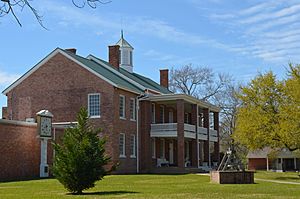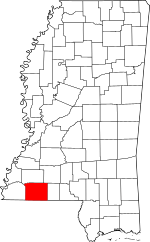Amite County, Mississippi facts for kids
Quick facts for kids
Amite County
|
|
|---|---|

Amite County courthouse in Liberty
|
|

Location within the U.S. state of Mississippi
|
|
 Mississippi's location within the U.S. |
|
| Country | |
| State | |
| Founded | 1809 |
| Named for | Amite River |
| Seat | Liberty |
| Largest town | Gloster |
| Area | |
| • Total | 736 sq mi (1,910 km2) |
| • Land | 730 sq mi (1,900 km2) |
| • Water | 1.5 sq mi (4 km2) 0.2% |
| Population
(2020)
|
|
| • Total | 12,720 |
| • Density | 17.283/sq mi (6.673/km2) |
| Time zone | UTC−6 (Central) |
| • Summer (DST) | UTC−5 (CDT) |
| Congressional district | 3rd |
Amite County is a county in Mississippi, right on its southern border with Louisiana. In 2020, about 12,720 people lived there. The main town, or county seat, is Liberty. The county gets its name from the Amite River, which flows through it. Amite County is also part of the larger McComb area.
Contents
Amite County's Past: A Look at Its History
After Native American tribes moved away in the 1830s, white settlers started large cotton farms here. These farms relied on the work of enslaved African Americans. Because of this, most people in the county were Black before the American Civil War. Growing cotton made many white farmers rich until the 1930s.
The Civil War and Its Impact
Amite County was not a major battleground during the American Civil War. However, a group of Union soldiers, led by Colonel Benjamin Grierson, camped near Liberty in April 1863. They were on a long journey as part of the Vicksburg Campaign.
After the War: Changes and Challenges
When the Civil War ended, about 60% of Amite County's population was African American. During a time called Reconstruction, formerly enslaved people, known as freedmen, were able to elect Black leaders to local jobs, like county sheriff.
However, after Reconstruction, white leaders in the state made it very hard for Black people to vote. They used things like poll taxes (a fee to vote) and reading tests. These rules were unfair and kept most African Americans and many poor white people from voting. This meant Black people were left out of the political system, even though they were the majority in the state until the 1930s.
Farming, Migration, and Population Changes
Amite County continued to be a farming area, later focusing on logging and dairy farms in the 1930s. As farming became more modern with machines, fewer farm workers were needed. This led many Black families to leave Amite County during the Great Migration. They moved to big cities in the North, like Chicago, and later to the West Coast, especially California, where there were many factory jobs.
Because of this, the county's population dropped a lot. From 1940 to 1960, the number of people living in Amite County went down by 29%. Some white families also left, but many more African Americans moved away.
The Fight for Civil Rights
In the 1950s, a local farmer named E.W. Steptoe started a chapter of the NAACP in the county. This group worked to help African Americans get their civil rights, including the right to vote. Herbert Lee, a farmer with nine children, was one of the first members.
In the summer of 1961, Robert Parris Moses from the Student Nonviolent Coordinating Committee came to Amite County. He helped Black people register to vote. He was attacked near the courthouse and told to leave for his safety. At that time, only one African American out of 5,500 in Amite County was registered to vote. Even after the Voting Rights Act of 1965 was passed, people still had to work hard to get everyone registered.
Sadly, violence against Black people in the county increased during the Civil Rights Movement. After these difficult times and a struggling economy, younger African Americans kept leaving the county for better jobs in cities. The population continued to drop. Today, most people in Amite County are white.
Important Historic Places
Many important places in Amite County are listed on the National Register of Historic Places. These include the Amite County Courthouse and the Westbrook Cotton Gin, which is the only one left from seven in the county. Old plantation houses and the Liberty and Bethany Presbyterian churches are also on the list.
Amite County's Location and Surroundings
The U.S. Census Bureau says Amite County covers about 732 square miles. Most of this (730 square miles) is land, and a small part (1.5 square miles) is water.
Main Roads in Amite County
Neighboring Counties and Parishes
Amite County shares borders with several other counties and parishes:
- Franklin County (to the north)
- Lincoln County (to the northeast)
- Pike County (to the east)
- Tangipahoa Parish, Louisiana (to the southeast)
- St. Helena Parish, Louisiana (to the south)
- East Feliciana Parish, Louisiana (to the southwest)
- Wilkinson County (to the west)
Protected Natural Areas
Part of the Homochitto National Forest is located within Amite County.
Towns and Communities in Amite County
Amite County has several towns and smaller communities.
Main Towns
- Centreville (most of it is in Wilkinson County)
- Crosby (part of it is in Wilkinson County)
- Gloster
- Liberty (this is the county seat)
Smaller Communities (Unincorporated)
Former Towns (Ghost Town)
Population and People of Amite County
| Historical population | |||
|---|---|---|---|
| Census | Pop. | %± | |
| 1810 | 4,750 | — | |
| 1820 | 6,853 | 44.3% | |
| 1830 | 7,934 | 15.8% | |
| 1840 | 9,511 | 19.9% | |
| 1850 | 9,694 | 1.9% | |
| 1860 | 12,336 | 27.3% | |
| 1870 | 10,973 | −11.0% | |
| 1880 | 14,004 | 27.6% | |
| 1890 | 18,198 | 29.9% | |
| 1900 | 20,708 | 13.8% | |
| 1910 | 22,954 | 10.8% | |
| 1920 | 18,960 | −17.4% | |
| 1930 | 19,712 | 4.0% | |
| 1940 | 21,892 | 11.1% | |
| 1950 | 19,261 | −12.0% | |
| 1960 | 15,573 | −19.1% | |
| 1970 | 13,763 | −11.6% | |
| 1980 | 13,369 | −2.9% | |
| 1990 | 13,328 | −0.3% | |
| 2000 | 13,599 | 2.0% | |
| 2010 | 13,131 | −3.4% | |
| 2020 | 12,720 | −3.1% | |
| 2023 (est.) | 12,442 | −5.2% | |
| U.S. Decennial Census 1790–1960 1900–1990 1990–2000 2010–2013 2020 |
|||
How the Population Has Changed
The number of people living in Amite County has gone down since its highest point in 1910, when there were 22,954 residents. This happened because farming became more mechanized, meaning fewer people were needed for farm work. Many people moved to cities for more job opportunities.
From 1910 to 1930, and again from 1940 to 1970, the county was greatly affected by the Great Migration. During this time, many Black families left the South to find jobs and escape unfair treatment in cities in the Midwest and West Coast. For example, from 1910 to 1920, the population dropped by more than 17%.
Black people left to escape the harsh rules of Jim Crow laws, violence, and being stopped from voting after 1890. From 1940 to 1960, the population dropped by over 29%. While some white people also left, many more African Americans moved away. After 1930, African Americans became a smaller part of the county's population. In 2000, they made up almost 43% of the people living there.
Who Lives in Amite County Today?
According to the 2020 United States census, there were 12,720 people living in Amite County. These people lived in 5,218 households, with 3,401 of them being families.
| Race | Num. | Perc. |
|---|---|---|
| White (non-Hispanic) | 7,434 | 58.44% |
| Black or African American (non-Hispanic) | 4,835 | 38.01% |
| Native American | 25 | 0.2% |
| Asian | 31 | 0.24% |
| Other/Mixed | 266 | 2.09% |
| Hispanic or Latino | 129 | 1.01% |
In 2020, the people living in Amite County were mostly non-Hispanic white (58.44%) and Black or African American (38.01%). A smaller number of people were Native American (0.2%), Asian (0.24%), or identified as other or mixed races (2.09%). About 1.01% of the population was Hispanic or Latino.
Learning and Schools in Amite County
Amite County has one main school system, called the Amite County School District. For college, students can attend Southwest Mississippi Community College.
Famous People from Amite County
Many notable people have connections to Amite County:
- Louis Allen, an African-American property owner who was killed for his civil rights work.
- Carl Elkanah Bates, a leader of the Southern Baptist Convention.
- L. C. Bates, an African-American civil rights activist.
- Robert P. Briscoe, a four-star Admiral in the U.S. Navy and a World War II hero.
- Will D. Campbell, a white Baptist minister, author, and civil rights activist.
- Jerry Clower, a famous country comedian.
- J. C. Gilbert, who served in the Louisiana State Senate and House of Representatives.
- David Green, a Mississippi state legislator and businessman.
- Carl Augustus Hansberry, a businessman whose court case, Hansberry v. Lee, went to the U.S. Supreme Court. He was the father of playwright Lorraine Hansberry.
- William Leo Hansberry, a scholar and uncle of Lorraine Hansberry.
- E.H. Hurst, a white Mississippi state legislator who killed activist Herbert Lee and was not charged.
- Gabe Jackson, an American football player for the Oakland Raiders.
- Herbert Lee, an African-American farmer and father of nine, who was killed in 1961 during the Civil Rights Movement.
- William F. Love, a U.S. Representative from Mississippi.
- T. T. Martin, an evangelist known for his views against evolution in the 1920s.
- Frank A. McLain, a U.S. Representative from Mississippi.
- Anne Moody, a civil rights activist and author of Coming of Age in Mississippi.
- Glenn Moore, a well-known softball coach.
- Leon Perry, an American football player.
- Barney Poole, an American football player.
- Clyde V. Ratcliff, a member of the Louisiana Senate.
- Andy Rodgers, a Delta blues musician.
- George H. Tichenor, who invented an antiseptic.
- E. M. Toler, a doctor and coroner who served in the Louisiana State Senate.
- Linda T. Walker, a federal judge.
- James W. Washington Jr., an African-American painter and sculptor.
- Franklin Delano Williams, a Gospel music singer.
- Damien Wilson, an NFL player for the Dallas Cowboys.
See also
 In Spanish: Condado de Amite para niños
In Spanish: Condado de Amite para niños

